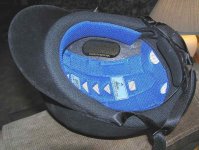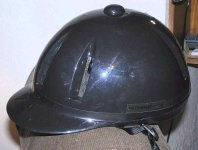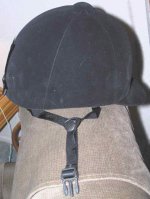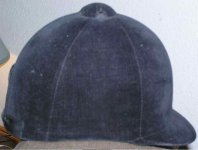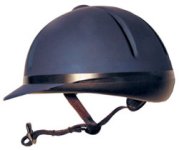♘امیرحسین♞
♘ مدیریت انجمن اسب ایران ♞
An Equestrian helmet is worn when riding horses. This type of helmet is specially designed to protect the rider's head if a person falls off a horse, especially if they should strike their head on a hard object while falling or accidentally be struck in the head by a horse's hoof.
Helmets that meet ASTM/SEI standards are required headgear for many horse show events, particularly classes like show jumping and show hunter where horse and rider have to jump. They are required in eventing, in endurance riding and other types of competitions in the United States and around the world. They are worn by most English-style riders and gaining acceptance as required headgear for children. People who take their horses trail riding often wear a helmet as well. They are recommended for all riders at all times when near or on the horse, though universal acceptance, particularly by adults in western riding sports such as rodeo, has yet to be achieved. Some states, such as New York, are starting to require by law that youth under the age of 14 wear helmets at all times they are riding.
Design
The helmet has a hard shell on the outside of an impact-resistant resin or plastic, sometimes covered with cloth for a more attractive look. The brim is particularly flexible and will give way immediately in the event a rider lands on it. Beneath the shell are materials designed to absorb the impact of a fall or blow. The inside is lined and often padded in order to be comfortable for the rider. Ventilation is usually worked into the design, and a harness is attached to keep the helmet on the head at all times.
While an equestrian helmet bears a superficial resemblance to a bicycle helmet, it is designed quite differently. Standards organizations that certify safety equipment perform some similar tests on all protective helmets (including bicycle, hockey and equestrian helmets), such as dropping them onto a flat anvil from a height of about six feet from several angles and directions. However, a second set of tests are designed to consider the particular risks of a given sport. For equestrian testing, the second set of tests includes having the helmet dropped onto an anvil with a very sharp corner, designed to simulate the impact of the square corner of a jump standard or a blow from a horse's hoof.[1] Further, a visual inspection of different types of helmet reveals more sport-specific differences: the equestrian helmet covers more of a person's head than does a bicycle helmet, fitting lower on the head, particularly at the back of the skull, and has protection distributed evenly around the head rather than concentrated in the front and back. Aside from safety features, aerodynamics are not as important in a riding helmet as with a bicycle helmet, but equestrians require a classic appearance, good ventilation and comfort.
Standards and Rules
Helmets must meet a rigorous safety standard. First, the design standards are set and approved by ASTM International (formerly American Society for Testing and Materials). Then, actual helmets are tested and certified by the Safety Equipment Institute (SEI), which also enforces compliance. ASTM/SEI-approved helmets are required by the United States Equestrian Federation in classes that mandate helmets to be worn. At the international level, in FEI competition, the standards of the International Organization for Standardization (ISO) are followed. However, as SEI is accredited to ISO/IEC Guide 65:1996 by the American National Standards Institute (ANSI) and the Standards Council of Canada (SCC), ISO standards and ASTM/SEI standards are quite similar.
Some riders feel that riding helmets are hot, uncomfortable or unattractive and do not want to wear them. However, the classic hunt cap, which modern helmets attempt to resemble, offered little or no protection to the rider of the horse. Neither do other types of hats popular with riders, including the derby, cowboy hat and the top hat. Use of helmets by beginning riders is becoming the standard, however, and most riding instructors cannot obtain liability insurance if they do not require all students to wear them.
The United States Equestrian Federation (USEF) requires all junior riders (under the age of 18) in any hunt seat discipline to wear an ASTM/SEI-approved helmet with harness fastened while mounted on their horse anywhere on the show grounds. Adults and youths both must wear helmets when jumping anywhere on the show grounds. While other horse show events do not mandate helmets, the rules have changed in recent years to permit helmets to be optional headgear in any class. All riders are required to wear certified helmets while competing in Hunter, Jumpers, and Hunt Seat Equitation classes, and in any other class, including Hunter Hack, where jumping is required. They must fasten their helmets and have to verify that their headgear that meets or exceeds ASTM/SEI standards for equestrian use and carries the SEI tag.
Aesthetic and symbolism
Riding helmets traditionally reflect the conservative style of dress that characterized earlier non-protective English riding headwear. The classic riding helmet is covered in black velvet or velveteen (either via a removable cover or permanently glued on), with a small, flexible, visor-style brim.
More recently, smooth finish helmets, worn without a fabric cover, have become more common. A newly popular style in the hunter-jumper world features a lightly textured (less shiny) plastic shell with a decorative ventilation strip down the center. This design goes by many brand names, but, due to the ventilation strip, is informally called a "skunk helmet."
Jockeys who ride race horses wear a helmet designed without a brim, adding a colorful cover that matches the rider's racing silks with a false brim for appearance's sake. Use of racing style colored helmet covers has spread to other disciplines, especially amongst Eventers. Causal riders often wear "training" or "schooling" helmets in a variety of colors and some even include patterns (such as stars or stripes). Cloth covers in brilliant colors and vivid designs can be purchased to provide even more variety, but are frowned upon (and are sometimes illegal) in the horse show ring, where black, brown or gray are still the standard.
Some helmets retain a symbolic ribbon at the back, which dates from mounted hunting. Traditionally, black ribbon was used for fox hunting or general hunting, with red ribbon used when stag hunting or arme blanche hunting. The ribbon was "sewn up" (i.e. with a bow at the base of the helmet and the tail ends of the ribbon either cut off or glued pointing upwards on the body of the helmet) for "common" riders. The ribbon was "sewn down" (i.e. with the tail ends dangling from the the bow, below the edge of the helmet) for hunt masters and hunt staff. Because any rider is entitled to wear a sewn up black ribbon, this is the standard for modern helmets retaining the ribbon. The use of "sewn down" ribbons by those not entitled to them sometimes occurs in the United States but is considered a serious transgression by traditionalists.
In some nations, members of the cavalry wear silver ribbons and national athletes wear gold ribbons. The ribbons are sewn up for troopers and common riders, and sewn down for officers and riders who have represented their countries at the Olympics or championships such as the World Equestrian Games.
Helmets that meet ASTM/SEI standards are required headgear for many horse show events, particularly classes like show jumping and show hunter where horse and rider have to jump. They are required in eventing, in endurance riding and other types of competitions in the United States and around the world. They are worn by most English-style riders and gaining acceptance as required headgear for children. People who take their horses trail riding often wear a helmet as well. They are recommended for all riders at all times when near or on the horse, though universal acceptance, particularly by adults in western riding sports such as rodeo, has yet to be achieved. Some states, such as New York, are starting to require by law that youth under the age of 14 wear helmets at all times they are riding.
Design
The helmet has a hard shell on the outside of an impact-resistant resin or plastic, sometimes covered with cloth for a more attractive look. The brim is particularly flexible and will give way immediately in the event a rider lands on it. Beneath the shell are materials designed to absorb the impact of a fall or blow. The inside is lined and often padded in order to be comfortable for the rider. Ventilation is usually worked into the design, and a harness is attached to keep the helmet on the head at all times.
While an equestrian helmet bears a superficial resemblance to a bicycle helmet, it is designed quite differently. Standards organizations that certify safety equipment perform some similar tests on all protective helmets (including bicycle, hockey and equestrian helmets), such as dropping them onto a flat anvil from a height of about six feet from several angles and directions. However, a second set of tests are designed to consider the particular risks of a given sport. For equestrian testing, the second set of tests includes having the helmet dropped onto an anvil with a very sharp corner, designed to simulate the impact of the square corner of a jump standard or a blow from a horse's hoof.[1] Further, a visual inspection of different types of helmet reveals more sport-specific differences: the equestrian helmet covers more of a person's head than does a bicycle helmet, fitting lower on the head, particularly at the back of the skull, and has protection distributed evenly around the head rather than concentrated in the front and back. Aside from safety features, aerodynamics are not as important in a riding helmet as with a bicycle helmet, but equestrians require a classic appearance, good ventilation and comfort.
Standards and Rules
Helmets must meet a rigorous safety standard. First, the design standards are set and approved by ASTM International (formerly American Society for Testing and Materials). Then, actual helmets are tested and certified by the Safety Equipment Institute (SEI), which also enforces compliance. ASTM/SEI-approved helmets are required by the United States Equestrian Federation in classes that mandate helmets to be worn. At the international level, in FEI competition, the standards of the International Organization for Standardization (ISO) are followed. However, as SEI is accredited to ISO/IEC Guide 65:1996 by the American National Standards Institute (ANSI) and the Standards Council of Canada (SCC), ISO standards and ASTM/SEI standards are quite similar.
Some riders feel that riding helmets are hot, uncomfortable or unattractive and do not want to wear them. However, the classic hunt cap, which modern helmets attempt to resemble, offered little or no protection to the rider of the horse. Neither do other types of hats popular with riders, including the derby, cowboy hat and the top hat. Use of helmets by beginning riders is becoming the standard, however, and most riding instructors cannot obtain liability insurance if they do not require all students to wear them.
The United States Equestrian Federation (USEF) requires all junior riders (under the age of 18) in any hunt seat discipline to wear an ASTM/SEI-approved helmet with harness fastened while mounted on their horse anywhere on the show grounds. Adults and youths both must wear helmets when jumping anywhere on the show grounds. While other horse show events do not mandate helmets, the rules have changed in recent years to permit helmets to be optional headgear in any class. All riders are required to wear certified helmets while competing in Hunter, Jumpers, and Hunt Seat Equitation classes, and in any other class, including Hunter Hack, where jumping is required. They must fasten their helmets and have to verify that their headgear that meets or exceeds ASTM/SEI standards for equestrian use and carries the SEI tag.
Aesthetic and symbolism
Riding helmets traditionally reflect the conservative style of dress that characterized earlier non-protective English riding headwear. The classic riding helmet is covered in black velvet or velveteen (either via a removable cover or permanently glued on), with a small, flexible, visor-style brim.
More recently, smooth finish helmets, worn without a fabric cover, have become more common. A newly popular style in the hunter-jumper world features a lightly textured (less shiny) plastic shell with a decorative ventilation strip down the center. This design goes by many brand names, but, due to the ventilation strip, is informally called a "skunk helmet."
Jockeys who ride race horses wear a helmet designed without a brim, adding a colorful cover that matches the rider's racing silks with a false brim for appearance's sake. Use of racing style colored helmet covers has spread to other disciplines, especially amongst Eventers. Causal riders often wear "training" or "schooling" helmets in a variety of colors and some even include patterns (such as stars or stripes). Cloth covers in brilliant colors and vivid designs can be purchased to provide even more variety, but are frowned upon (and are sometimes illegal) in the horse show ring, where black, brown or gray are still the standard.
Some helmets retain a symbolic ribbon at the back, which dates from mounted hunting. Traditionally, black ribbon was used for fox hunting or general hunting, with red ribbon used when stag hunting or arme blanche hunting. The ribbon was "sewn up" (i.e. with a bow at the base of the helmet and the tail ends of the ribbon either cut off or glued pointing upwards on the body of the helmet) for "common" riders. The ribbon was "sewn down" (i.e. with the tail ends dangling from the the bow, below the edge of the helmet) for hunt masters and hunt staff. Because any rider is entitled to wear a sewn up black ribbon, this is the standard for modern helmets retaining the ribbon. The use of "sewn down" ribbons by those not entitled to them sometimes occurs in the United States but is considered a serious transgression by traditionalists.
In some nations, members of the cavalry wear silver ribbons and national athletes wear gold ribbons. The ribbons are sewn up for troopers and common riders, and sewn down for officers and riders who have represented their countries at the Olympics or championships such as the World Equestrian Games.

